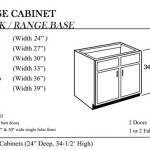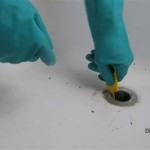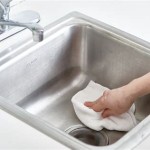How To Take Out A Sink Drain
Removing a sink drain is a common plumbing task that homeowners might encounter during sink replacements, repairs, or clogs. While seemingly straightforward, proper execution is crucial to avoid leaks and potential damage to the plumbing system. This article provides a comprehensive guide on how to safely and effectively remove a sink drain.
Before commencing any plumbing work, safety should be paramount. Always turn off the water supply to the sink. Typically, shut-off valves are located directly beneath the sink. Turning these valves clockwise will halt the water flow. After shutting off the valves, turn on the faucet to relieve any residual pressure in the pipes. Place a bucket beneath the drain assembly to catch any remaining water that may be trapped within the pipes. It is also advisable to wear gloves to protect hands from grime and potential contaminants present within the drain system.
Identifying the Drain Type and Components
Sink drains come in various designs, but the most common types include pop-up drains, basket strainers, and grid drains. Each type has slightly different removal requirements. Pop-up drains are often found in bathroom sinks and feature a lever that controls a stopper. Basket strainers are typical in kitchen sinks and include a strainer basket that prevents large debris from entering the drainpipe. Grid drains are commonly found in lavatories and lack a stopper, featuring a grid-like structure to prevent larger objects from passing through.
Regardless of the drain type, the general components are similar. The drain body, also known as the tailpiece, extends downwards from the sink basin. This tailpiece connects to the P-trap, a curved pipe designed to trap debris and prevent sewer gases from entering the home. The drain flange sits within the sink basin and is secured by a nut underneath the sink. Understanding these components is essential for properly disassembling the drain assembly.
The specific connections within the drain assembly may vary. Some connections use threaded fittings, while others employ slip nuts and compression rings. Threaded fittings are tightened by rotating the pipes, while slip nuts compress rubber or plastic rings to create a watertight seal. Identifying the connection type is crucial to using the correct removal technique.
Tools and Materials Required
Having the correct tools readily available will significantly simplify the drain removal process. Essential tools include:
- Basin Wrench: This specialized wrench is designed to reach tight spaces beneath the sink. It has a swiveling head that allows for maneuvering in awkward angles.
- Channel-Lock Pliers: These adjustable pliers are useful for gripping and loosening various parts of the drain assembly.
- Pipe Wrench: A pipe wrench is a heavier-duty tool used for loosening larger, more stubborn threaded connections. It's typically only necessary for older plumbing systems.
- Screwdriver (Phillips and Flathead): Screwdrivers are needed for removing screws that may be holding parts of the drain assembly together, particularly with pop-up drains.
- Putty Knife or Scraper: A putty knife is helpful for removing old plumber's putty from the sink flange.
- Bucket: As previously mentioned, a bucket is essential for catching water and debris during the removal process.
- Rags or Towels: Rags or towels are useful for cleaning up spills and wiping down parts of the drain assembly.
- Penetrating Oil: Penetrating oil can help loosen corroded or stuck nuts and bolts.
In addition to the tools, certain materials may be required:
- Plumber's Putty: This pliable material creates a watertight seal between the sink flange and the sink basin.
- Teflon Tape: Teflon tape is used to seal threaded connections and prevent leaks.
- Replacement Parts: If any parts of the drain assembly are damaged or corroded, replacement parts should be on hand.
Step-by-Step Drain Removal Procedure
The drain removal process comprises several key steps, starting with disconnecting the P-trap and working upwards towards the sink basin.
1. Disconnecting the P-Trap: The initial step involves disconnecting the P-trap from the tailpiece and the drainpipe leading to the wall. Locate the slip nuts that connect the P-trap to these pipes. Use channel-lock pliers to loosen these nuts. It may be necessary to use penetrating oil if the nuts are particularly stubborn. Once loosened, carefully slide the nuts back and detach the P-trap. Be prepared for water to spill out, so ensure a bucket is positioned underneath.
2. Removing the Pop-Up Drain Mechanism (if applicable): If the sink has a pop-up drain, the next step is to disconnect the linkage that controls the stopper. Typically, this linkage consists of a horizontal rod connected to a vertical rod. Locate the retaining clip or screw that secures the horizontal rod to the drainpipe. Remove the clip or screw and detach the rod. The vertical rod can then be pulled out from the top of the sink.
3. Loosening the Drain Nut: The drain flange is held in place by a large nut located beneath the sink. This nut can be challenging to access and loosen, especially if corroded. Use a basin wrench to grip the nut. Adjust the wrench so that it firmly grasps the nut. Apply firm, even pressure to loosen the nut. It may be necessary to use penetrating oil to assist in loosening a particularly stubborn nut. Continue turning the nut until it is completely removed.
4. Removing the Drain Flange: Once the nut is removed, the drain flange should be free to be pushed upwards and out of the sink basin. If the flange is stuck, use a putty knife to carefully break the seal of the old plumber's putty. Gently rock the flange back and forth to loosen it. Once loosened, carefully lift the flange out of the sink basin.
5. Cleaning the Sink Basin: After removing the drain flange, thoroughly clean the area around the drain opening in the sink basin. Remove any remaining plumber's putty or debris. Use a scraper or putty knife to remove stubborn residue. Ensure the surface is clean and dry before installing a new drain.
Addressing Common Challenges
Several challenges may arise during the drain removal process. Corroded nuts and bolts are a common issue. Applying penetrating oil liberally and allowing it to soak for several minutes can often loosen stubborn connections. If the basin wrench slips off the nut, ensure it is properly adjusted and apply more pressure. If the nut is excessively corroded, it may be necessary to use a pipe wrench for greater leverage. However, caution should be exercised to avoid damaging the drainpipe.
Another challenge is dealing with tight spaces. The basin wrench is designed for these situations, but maneuvering it can still be difficult. Patience and persistence are key. Ensure adequate lighting is available to clearly see the drain assembly. Using a mirror can also be helpful for visualizing hard-to-reach areas.
If the P-trap is severely corroded or damaged, it may need to be replaced. P-traps are relatively inexpensive and can be easily found at most hardware stores. Ensure the replacement P-trap is the correct size and type for the existing plumbing system.
During the drain removal process, it's possible to damage existing plumbing. Avoid excessive force when loosening nuts and bolts. If a pipe is accidentally damaged, it should be repaired immediately to prevent leaks. Pipe repair clamps or epoxy putty can be used for temporary repairs, but a more permanent solution, such as replacing the damaged section of pipe, may be necessary.
When working with old plumbing, it's possible to encounter lead pipes or lead solder. Lead is a toxic substance, and exposure should be minimized. Wear gloves and a mask to protect against contamination. Dispose of any lead-containing materials properly according to local regulations.
Occasionally, the drain flange may be virtually impossible to remove due to years of corrosion and mineral buildup. In situations where the flange is effectively fused to the sink, using a reciprocating saw with a metal-cutting blade can be a last resort. Exercise extreme caution to avoid damaging the sink itself. Cut the flange into several pieces to relieve the pressure and facilitate removal.
How To Remove A Kitchen Sink Drain 13 Steps With Pictures
5 Natural Ways To Unclog A Bathroom Sink Hiller How
How To Clean Out A Sink Pop Up Drain Stopper Youtube
How To Replace A Rusty Sink Drain Howtolou Com
Plumbing How Do I Remove The Sink Drain In This Situation Home Improvement Stack Exchange
How To Remove A Bathroom Sink Pop Up Stopper
How To Replace A Sink Stopper Quick And Simple Home Repair
How To Replace A Bathroom Sink Drain
Sink Maintenance How Do I Remove A Pop Up Drain
How To Unclog Clean A Bathroom Sink Drain 3 Methods







